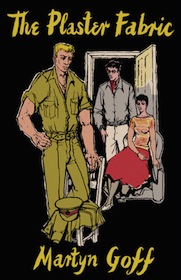 The Plaster Fabric
The Plaster Fabric
by Martyn Goff
Valancourt Books. 200 pages, $16.99
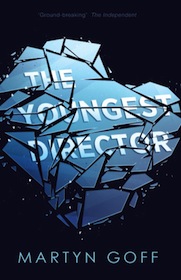 The Youngest Director
The Youngest Director
by Martyn Goff
Valancourt Books. 218 pages, $15.99
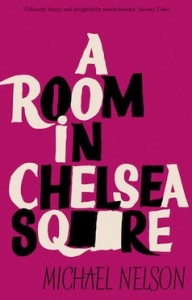 A Room in Chelsea Square
A Room in Chelsea Square
by Michael Nelson
Valancourt Books. 164 pages, $15.99
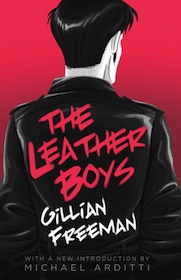 The Leather Boys
The Leather Boys
by Gillian Freeman
Valancourt Books. 155 pages, $14.99
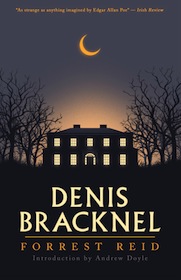 Denis Bracknel
Denis Bracknel
by Forrest Reid
Valancourt Books. 226 pages, $16.99
Harmonica’s Bridegroom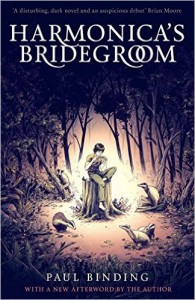
by Paul Binding
Valancourt Books. 169 pages, $14.99
REDISCOVERING the history of gay and lesbian fiction has never been easier. Thanks to intrepid small publishers such as Valancourt Books of Richmond, Virginia, it has become possible to explore the byways of gay fiction: the many publications that may have caused a great splash on publication but were soon forgotten. For every Forster or Woolf, there were a hundred fellow travelers: authors whose works constitute what the art critic John Ruskin called “the books of the hour,” not “the books of all time” (“Sesame and Lilies,” 1891). Still, there is always the possibility that a long-neglected work, on republication, may strike a wide new readership as falling in the latter category: such as—in the non-gay context—Irène Némirovsky’s Suite Française. GLBT titles from the past often have a vexed and curious publication history too. Take Forster’s Maurice, completed in 1914, but unpublished until 1971 (his own decision).
There are many good reasons to spend time discovering both the books of the hour and books potentially with greater staying power. Half a dozen recently republished postwar British novels on gay male themes present an irresistible opportunity to reflect and discriminate.
Martyn Goff
The Plaster Fabric (1957) tells the story of Laurie, a London-based bookseller and artist whose homosexuality has been artfully concealed at work, at home, and among his peers—though arguably it is rather blatantly evident in the original jacket cover illustration by gay artist John Minton, reproduced on the Valancourt edition. One night, Laurie succumbs to temptation, picking up a young blond soldier named Tom, a classic embodiment of the period’s “gay for pay” constituency. Tom is described as having unfeasibly outsized hands, while his “huge body” is described repeatedly as “white and magnificent.”
A complex love triangle ensues: the nominally heterosexual Tom starts a relationship with Laurie’s best friend Susan. Self-doubt and ultimately self-denial come next—no surprise to readers familiar with those staples of 1950s gay British fiction, Rodney Garland’s The Heart in Exile and Mary Renault’s The Charioteer (both 1953). Goff intersperses some less bleak moments, appeals for sympathy and understanding for the sexual minority, and offers some vivid accounts of the nascent gay male subculture in both London and coastal Brighton. A sojourn Laurie spends in Florence with a protective older partner illustrates the contrasting mores of continental Europe and their associated erotic opportunities. A street-boy announces to Laurie: “A lot of English writers come to Firenze.”
Poet John Betjeman’s glowing review of The Plaster Fabric in the Daily Telegraph propelled it into public consciousness, though the aspects he commended announce all too clearly the straitened context in which Goff chose to address—or was able to address—the homosexual theme. Betjeman was impressed by “the sense of impending doom, of the hostility of society, of insecurity, and the constant terror of betrayal.” As Martin Dines argues, Betjeman seems to have been relieved by Laurie’s repeated renunciation of his own sexual nature, and the novel’s emphatic indication that his hobby, portrait painting, offers a compensatory outlet for these desires. However, as Dines duly observes, the Telegraph reviewer conveniently ignored that Laurie also had a secondary infatuation—with a striking teenage boy named Martin, with whom he inadvertently comes to share a bed.
The young Martin, while insisting on chasteness throughout the encounter, suggests by his openness a future world of greater sexual self-realization than Laurie himself could hope to experience:
“Let go!” said Martin quietly, his voice even and matter of fact.
“Why?” Laurie was pleading already.
“You’d only be ashamed in the morning,” replied the boy softly. Without waiting he pulled his arm free, moved farther to his own side of the bed and, turning over, appeared to have fallen asleep at once.
Four years later, in contrast, The Youngest Director (1961) allowed Goff’s gay protagonist to secure the young man of his dreams: John, a man in his early twenties. The book tells of the “youngest director” of a big London corporation, Leonard Bissel, and his attempts to settle down with John like his heterosexual peers. The twin threats to this are institutional and social: on the one hand, his bosses expect him to serve the interests of his employer through marriage; on the other, John’s extensive set of gay friends and sometime lovers constitute a Hydra-like monster of sexual temptation. The gay world—as in James Baldwin’s contemporary Giovanni’s Room (1956), set in Paris—is depicted as entirely shallow, mercenary, and opportunistic.
There being no social legitimacy for gay relationships at that time, most queer men embrace a sexual free-for-all that both Leonard and Goff find repulsive. What Leonard terms the “vertical relationship”—one which is differentiated through age, class, education, or social standing—had played a much smaller role in The Plaster Fabric, but here it dominates. The young hotel employee John develops a sense of inferiority to Leonard, and suspects that he’s becoming little other than Leonard’s “possession.” Paradoxically, “horizontal” relationships—those between equals—are shown to be potentially more practical and enduring, but invariably far less sexually alluring.
Michael Nelson and Gillian Freeman
Michael Nelson’s A Room in Chelsea Square (1958) and Gillian Freeman’s The Leather Boys (1961) are scarcely lost texts. Both were reprinted in the 1980s or ’90s by London’s now-defunct Gay Men’s Press. Nelson’s novel is a roman à clef, its fictionalized characters based on Cyril Connolly, the author and editor of Horizon magazine, and 1930s poet Stephen Spender, among others. Stylistically slight, it was apparently inspired by Nelson’s frustrations on finding his own literary promise overlooked by Connolly, Spender, and others close to gay author and editor John Lehmann, for whom Nelson worked as a secretary. The novel recounts the many abuses experienced by young, on-the-make Nicholas Milestone at the hands of the “very, very rich” Patrick, an acid portrait of Peter Watson, the co-founder of Horizon.
In his introduction to Chelsea Square, Gregory Woods proves reluctant to make sizable claims for the novel, which was something of a critical and commercial success in its day. Again Betjeman was on hand to review it, finding Nelson “talented and amusing” and claiming that “the various men in it are not merely types, but flesh and blood, even if one wishes that Patrick had never been born”—a quotation which suggests that he probably knew very well on whom Nelson’s characters were based. Malcolm Bradbury thought it “wonderfully developed in the best Machiavellian tradition.” Julian Maclaren-Ross called it “consistently diverting,” adding, absurdly: “this may be the novel about homosexuality to end all novels on the subject.”
The distinction between “vertical” and “horizontal” gay relationships recurs as a theme, with Nelson suggesting that Patrick would cope better with an illiterate, working-class boy on call than with the ambitious, relatively well-educated Nicholas, who proves less of a milestone than a millstone to the older man. In this account of gay relationships, intriguingly, it is the young Nicholas who desires security, only to find that he is universally considered merely Patrick’s latest passing fad.
The coterie around Patrick reflects his own objectionable values—of social and sexual dominance, possessiveness and transience—with “Christopher” (the Spender character) opining brusquely: “if an artist is going to produce something really alive, he must be loved by someone. That’s why good artists are often so promiscuous.” Christopher himself, though married, is a fully realized bisexual character. Patrick, meanwhile, retains a belief that the novel bears out—that the only value which might prove equal to beauty in gay relations is money: “It was no good pretending that he was still young. Age was an inevitability that had to be faced. He didn’t expect young men to be attracted by his looks any more. But there was no reason why they shouldn’t be nice to him for his money.” Of Nelson’s many conspicuous references to Wilde’s Picture of Dorian Gray, Patrick’s reflection on Nicholas’ “delusion that he was indispensible” is worth quoting: “Perhaps he didn’t know that young men were like pictures you wanted to buy. You determined your top price. Beyond that you were not prepared to bid. Quite often you bought them well below your price.”
The Leather Boys, meanwhile, is distinctive for several reasons: it was written by a heterosexual woman; the gay “Romeo and Romeo” theme was suggested to her by her publisher, Anthony Blond; and, most surprisingly, it was turned into a film in 1964 starring Dudley Sutton and Colin Campbell as Reggie and Dick, two bikers who fall for one another, as well as Rita Tushingham as Reggie’s unloved wife Dot. As Michael Arditti argues, the film—perhaps more than the novel—made a pitch for the normality of male homosexuality, offering one of the first portrayals of it between working-class characters, thus avoiding the pitfalls of the “vertical” model rooted in class or material inequalities. All this, more than three decades before Jonathan Harvey’s play Beautiful Thing—also set in South London, and also subsequently filmed—was acclaimed for similar reasons.
The Leather Boys was and remains groundbreaking, but it suffers from a limited range of expression: the downside of its most singular achievement, the capturing of unaffected, youthful, working-class speech. Freeman’s characterization allows for two contrasting but limited accounts of gay male self-awakening. Dick, a virgin, experiences a “pure” attraction, which grows from an initial inchoate longing for a brother figure or special friend. In Reggie, however, the appeal of Dick—and, yes, the obvious joke is made—lies in his difference from Dot, whose femininity her husband abhors.
A degree of misogyny informs both characterizations, in terms again reminiscent of Giovanni’s Room and Baldwin’s characterization of his bisexual protagonist, David. When Dick is accompanied by the needy Rose, for example, who demands a kiss, we are told: “Horrified, his mouth touched hers, and her lips seemed to grow like the fleshy tentacles of a sea anemone and draw him into the wet, dark, devouring cavity within. He tried to draw away but she clung to him, her body flattened to his, her arms and her legs and her mouth holding him.” If Dick and Reggie’s developing intimacy is secured by way of their shared disdain for women, no less unattractive is Freeman’s gallery of gay grotesques, a group of sailors the boys meet when considering merchant shipping as a means of escape from Albion: “Dick thought of the ugly, middle-aged powdered faces. He had never seen homosexuals like them before. He had never thought of his relationship with Reggie as being homosexual, he hadn’t labeled it or questioned it. It wasn’t like this. They would never be like these men.”
Forrest Reid and Paul Binding
The two novels that bookend the group chronologically—Ulster-born Forrest Reid’s posthumous Denis Bracknel (1947) and Englishman Paul Binding’s Harmonica’s Bridegroom (1984)—point to the greater range of narrative possibilities in British fiction in both the inter-war years and the 1980s, a decade that saw both the acute stigmatization of gay people during the AIDS crisis and a growing social assertiveness of the GLBT rights movement.
Forrest Reid (1875-1947) remains one of the great unsung heroes of the earlier period. Acclaimed in his lifetime by E. M. Forster and D. H. Lawrence, Reid published over a dozen novels that dramatized and even celebrated love between two adolescent boys or between a boy and an older man. Reid naïvely dedicated the extraordinary novella The Garden God (1905) to his idol, Henry James, without securing his clear permission. James was appalled by it frank, pagan account of boy-boy romantic friendship and refused any further contact with its author. The Bracknels (1911) saw Reid address the mysterious, almost otherworldly attraction between a pupil too fragile to survive public school and the tutor who comes to home-educate him.
Late in life, Reid returned to several early fictions, including The Bracknels, and rewrote them in his more succinct “late style.” Denis Bracknel was the result. The novel’s haunting, pellucid prose recounts the tragic attraction between Denis, its ethereal, lunar-worshipping fifteen-year-old protagonist and Hubert Rusk, an inexperienced tutor, straight down from Cambridge. In a pivotal encounter, the rational-minded Rusk encounters the romantic Denis, “this naked pagan boy, with body bared to the whiteness of the moon.” Consciously or not, the boy, “like a figure in a dream,” re-enacts an obscure, pre-Christian devotional ceremony:
Denis advanced into the middle of the grove, and there was something in his movements, a kind of rhythmic precision and alacrity that was yet not haste, which gave Rusk a momentary impression that he might be walking in his sleep. The possibility brought him a sudden hope, but of this hope he was doomed to swift disappointment, when he watched the boy uncover the altar and place a moon-shaped object upon it. This object, Rusk saw, was decked with white tapers—tapers Denis was now lighting. When all were ablaze he bowed low before them as to some unseen presence, and then proceeded to go through the most amazing ceremony Rusk was ever likely to behold.
Andrew Doyle argues that the novel perpetuates an established trope in Reid’s fiction: the primal struggle between good and evil. True; but this unforgettable book offers much else besides. It brings into proximity two contrasting sensibilities—one realistic, the other fantastical. It absorbs both in its own formal texture, oscillating between naturalistic and imaginative narrative modes. If many of his books—the majority now disinterred by Valancourt—demand contemporary attention, Denis Bracknel may yet be Reid’s finest achievement: among the best expressions of intergenerational attraction, youthful idealism, and blighted innocence.
Among the first generation of gay literary critics, Paul Binding’s debut novel Harmonica’s Bridegroom (1984) is a quintessentially English novel, especially winning in its portrayal of the limitations but also the occasional opportunities inherent in provincial English life, notwithstanding that much of it takes place in Spain and the American South. A new afterword by the author explains that the novel sprang from Binding’s observation of an attractive boy on a Madrid boulevard while researching a nonfiction book about Lorca.
Harmonica’s Bridegroom is set in Tanbury, based on the Midlands market town Banbury, which both conditions and continuously haunts the lives of the Varney family, particularly those of Dan and James, two brothers who grow up idolizing one another. Dan, who turns out gay, carries into adulthood the mesmerizing influence of his younger, straight brother James, the harmonica player of the title. James, in turn, plays a pivotal role in transforming the life of a needy young misfit, Kevin, whose chance erotic encounter with Dan much later reinforces the Thomas Hardy-like fatalistic threnody of Binding’s plot.
As in Hardy, there is the occasional overplaying of coincidence. But for a first fiction particularly, Harmonica’s Bridegroom is an extraordinarily mature achievement, nowhere better than in adumbrating the cross-generational tension between Dan and Kevin:
Dan found himself thinking—for all the similarities that doubtless inhabited the caverns of their two beings—how different he at twenty-four had been from Kevin now. He’d never positioned himself on a gay promenade in advertising red sweater and socks, he’d never haunted pick-up bars. Instead serious conversations with Richard, punctuated with innocent jokes, evenings of music on the gramophone and in concert halls: Haydn and Beethoven quartets, Schubert and Schumann lieder…
Binding’s “Afterword” notes that “the people of my book were very much alive to me as I reread it.” He provides the reader with a winning update on all their lives. I would far rather have had a sequel to this superior, memorable tale. Nonetheless, the way in which Binding’s characters continued to live for the author struck this reader as utterly earned. Like Reid’s characters in Denis Bracknel, they deserve a place in GLBT hearts and minds not just for the occasional revival but just possibly for all time.
Richard Canning is author or editor of nine books, including an edition of Ronald Firbank’s Vainglory (Penguin Classics, 2012).





